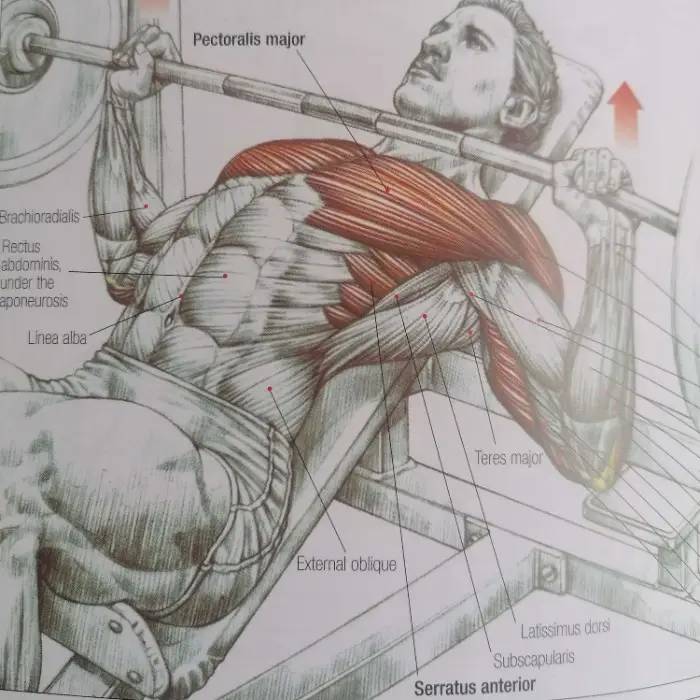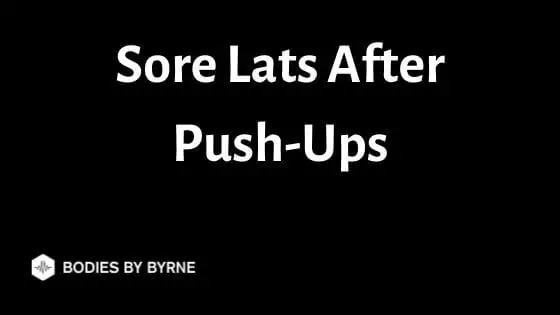One of the most common things you’ll likely experience when training with bodyweight exercises is a feeling of soreness in muscle groups that you are not intentionally training.
One of the best examples of this is the push-up. This exercise is designed to target the chest, triceps, and front deltoids but how many times have you done push-ups to failure and found the next day that your lats are sore (despite being a pulling muscle). This is definitely a confusing scenario for most beginners.
So, do you have sore lats after push-ups?
The lats function as a stabilizing muscle for your hips and torso during a push-up so do receive stimulation which could cause muscle soreness. For most people, however, sore lats are often confused with sore serratus anterior muscles located next to the lats which are very active during a push-up.
9 times out of 10, people confuse lat soreness with teres minor, teres major, and serratus anterior soreness. I used to think the same thing and couldn’t understand why my back was sore after push-ups but it’s because these muscles are all so closely positioned together, it’s easy to get them mixed up.
In this article, I’ll cover why your lats (and the other muscles mentioned) are sore after push-ups and what you can do to minimize this as much as possible with some simple form corrections.
Table of Contents
Sore Lats After Push-Ups
Firstly, It’s worth mentioning that if you have some working knowledge of muscle soreness and can definitely feel DOMS in your lats the next day, then I’m not here to question that. In terms of troubleshooting the soreness though, I’d suggest raising your arms overhead and really concentrate on where the muscle soreness is coming from.
My reason for saying this is that more often than not, it’s the serratus anterior (or possibly the teres minor/major) that you are feeling rather than the lats. I will cover why the lats specifically get sore during push-ups but for now, it’s good to note that it might not actually be the lats that feel sore.
While performing push-ups the serratus anterior contracts to maintain the scapula against the rib cage and locks the arm into the torso. You’ll also find that the lats are located directly above the serratus anterior (which is a muscle group surrounding the ribs) as shown by the image below.

If you are feeling sore lats anywhere around this area, it’s more likely to be the serratus anterior which is common as a result of its engagement during the push-up.
What Muscles Should Hurt After Push-Ups
The push-up is a versatile exercise that can easily be considered a full-body movement. This is often overlooked as the primary muscle groups that you’d expect to be sore after a push-up is the chest, triceps, and front deltoid.
When factoring in all of the other stabilizing muscles though, you’ll find that your abs, obliques, stabilizing muscles of the shoulder girdle, lats, glutes, quads, forearms and a range of smaller muscles are all active during a push-up.
A proper push-up is essentially a plank and a load of muscle groups are contracted and maintaining tension just to keep you in a stable position. This is something you don’t face when doing a bench press for example which targets the same primary muscle groups and is a similar movement but you’re lying down and supported.
This is why when going from a bench press to a push-up or starting with push-ups in your routine will lead to a range of other muscle groups being sore that you are not intentionally targeting. You’ll also find that movements like this will highlight weak points.
Why Do Lats Get Sore After Push-Ups
Now that I’ve briefly covered why other muscle groups are active during a push-up (for stabilization) it’s much easier to say why the lats get sore after push-ups and the reason is the same as that above.
While the serratus anterior definitely does more work as a stabilizing muscle during a push-up and is a primary reason why it’s likely to be this muscle that you actually feel sore, the lats are also working hard and contracting in a similar way.
You can’t eliminate the lats during a push-up because they act involuntarily. Therefore, you need to start making some adjustments to your form to better target the active muscles and place less stress on the stabilizing muscles.
Firstly, your hand positioning is going to be the most important factor to control. A high hand placement (with elbows flared outwards) is going to bring the lats into involvement a lot more. To demonstrate, try doing a plank with elbows tucked by your sides, and then after a short break try it with your elbows directly below your forehead.
The second variation is going to be much more difficult because your stabilizing muscles are going to have to work much harder and it’s likely to highlight any weaknesses or muscle imbalances.
For a push-up, the same principle applies so keep your elbows closer to your body (though not necessarily by your sides if you don’t want to engage the triceps too much) and keep the hand placement around shoulder-width apart.
Next, do push-ups with your feet slightly raised. This will shift some of the focus to your upper chest and front delts but it will also shift some of the stabilizing load away from the lats. In a regular push-up, your lats are helping to keep your hips stable but with your feet raised, your center of gravity will shift in a more favorable way.
Do Push-Ups Work the Lats
Push-ups do not directly work the lats. It’s a pushing movement as the name suggests and the target muscles are those responsible for pushing in the upper body. Just because the push-up doesn’t target and directly work the lats does not mean that they are not engaged during the movement though.
In terms of muscle fatigue and growth though, a standard push-up will not do much in terms of lat growth and the soreness is usually the result of the lats working as a stabilizing muscle rather than moving a load. There is however an exception to this with renegade rows.
Renegade rows are push-ups done holding a set of dumbells with palms facing inwards. Hex dumbbells are best for this as the flat edges allow for more stability. With a renegade row, you’ll do a push-up as normal but at the top of the movement, you’ll also do a single-arm row.
This is a hybrid exercise that makes the push-up a more complete upper body exercise and significantly improves lat engagement during the movement.
This isn’t an exercise for maximum hypertrophy as the weight you can use is seriously limited by your ability to lift it with an unstable body position and you are relying more on core strength than back strength for this exercise.
Therefore, it’s a good option for warmups/finishers or if you are short on equipment and need to get creative with some dumbbells.
Final Thoughts
If you are feeling sore lats after push-ups, this isn’t something that should come as a surprise or be an indication that you are doing something wrong. In fact, the opposite is true and sore lats will usually indicate that you are using good technique and the stabilizing muscles are doing what they should.
The soreness should not keep happening though once you get used to the movement and after a while, you should start to feel soreness in the primary muscle groups that you are targeting, mainly the chest and triceps.
